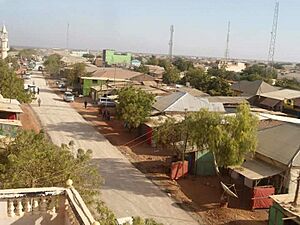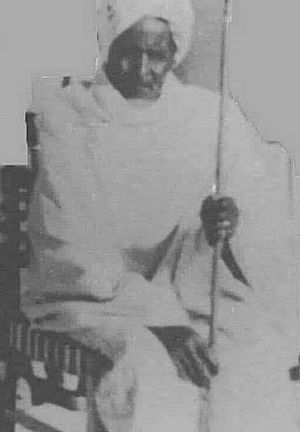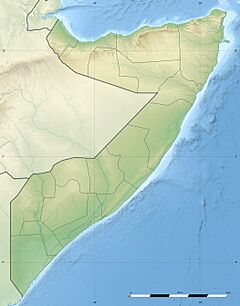Buuhoodle facts for kids
Quick facts for kids
Buuhoodle
بوهودله
|
||
|---|---|---|
|
City
|
||
 |
||
|
||
| Country | ||
| Khatumo State | ||
| Region | Cayn | |
| Government | ||
| • Type | District Council | |
| Population
(2006)
|
||
| • Total | 11,373 | |
| Time zone | UTC+3 (EAT) | |
Buuhoodle (Somali: Buuhoodle, Arabic: بووهودل), also known as Bohotle, is a major city in the Cayn region of Somalia. It is an important border town, helping goods move between the Khatumo State area and the Somali Region of Ethiopia. The land around Buuhoodle is known for its many livestock farms and growing agricultural activities.
Contents
What is Buuhoodle?
Buuhoodle is a city in Somalia that is very important for trade and travel between different regions and even countries. It is located in a dry area called Ciid, right on the border between Somalia and Ethiopia.
Who Controls Buuhoodle?
Buuhoodle is a city that different groups claim as their own. This means there is a "territorial dispute" over who should govern it.
Why is it Disputed?
Two main groups, Puntland and Somaliland, both claim Buuhoodle.
- Puntland says it should control the city because many people there belong to the same large clan (family group) as the main clan in Puntland.
- Somaliland says it should control the city because it was part of the old British Somaliland Protectorate, which had different borders.
Recent Control
Currently, local forces known as the SSC-Khaatumo administration control Buuhoodle. This group works to unite the Sool, Sanaag, and Cayn regions. Because of this dispute, elections held by Somaliland in 2021 did not take place in Buuhoodle.
There have been some disagreements and clashes in the past between these groups. For example, in 2010 and 2012, there were conflicts near Buuhoodle involving Somaliland and SSC Movement troops. These issues were eventually resolved.
A Look Back in Time
The Dervish Movement
Buuhoodle is famous for being where the Dervish Movement began. This was a group that fought against European colonial rule in the late 1800s and early 1900s.
- The Ali Gheri clan, who lived south of Buuhoodle, were among the first to join the Dervish Movement. They hosted its leader, Sayid Mohamed, when the movement was just starting.
- The Dervishes were strong fighters. In 1912, they attacked clans in the Buuhoodle area who were allies of the British. Many people had to leave their homes and seek safety in other cities like Burao and Berbera.
- The fighting caused a lot of hardship, and many people suffered from lack of food and safety during this time.

Buuhoodle Before Somalia's Independence
Records from 1937 describe the land around Buuhoodle as having gray-red sand and rocky areas. However, it was also a large meadow with many grasses and bushes, making it good for grazing animals.
Buuhoodle After the Somali Civil War
After the Somali Civil War, Buuhoodle was not controlled by either Somaliland or Puntland for some time.
- In 2001, the Puntland government officially claimed Buuhoodle as part of its territory.
- In 2002, Somaliland also set up a military division in the area, showing their interest in the region.
- The area has also faced droughts, like a major one in 2004.
Recent Events
- In 2009, the SSC group formed in Buuhoodle to create their own government.
- In 2012, a new group called Khatumo State was formed in Buuhoodle. They also had conflicts with Somaliland forces.
- In 2014, Somaliland forces moved into some villages near Buuhoodle.
- In 2015, the Puntland government helped vaccinate many goats in the Buuhoodle area.
- In 2019, a new version of the SSC group was formed in Buuhoodle, aiming to unite the regions of Sool, Sanaag, and Cayn.
- In 2020, a Somali government minister visited Buuhoodle to deliver medical supplies during the COVID-19 pandemic.
- In 2021, a woman named Khadija Ahmed Yussuf was elected as the mayor of Buuhoodle in a nearby town, becoming the first female mayor elected by majority vote in the area.
How Does Buuhoodle Make Money?
Buuhoodle is a busy trading center. Goods move through here to and from cities like Bosaso, Garowe, Las Anod, Galkayo, Wardheer, Burao, and the wider Ogaden region.
Both the Puntland and Somaliland governments have rules about taxes on goods.
- Puntland charges taxes on goods from the former British Somaliland area, but not on goods from Buuhoodle, since it's not under Somaliland's control.
- Somaliland has a customs office in Las Anod that taxes goods from Puntland. However, for areas like Buuhoodle, which are close by, the tax is reduced.
Who Lives in Buuhoodle?
In 2006, Buuhoodle had about 11,373 people. The larger Buuhoodle District had about 83,747 residents in 2014. Most people in Buuhoodle are from the Somali ethnic group. The Dhulbahante clan, especially the Ararsame and Bah Ali Gheri groups, are very common here.
Learning in Buuhoodle
Buuhoodle has many schools and places for learning.
- There are 12 primary schools and 3 high schools in the Buuhoodle District. Some primary schools include H/dh Abu-Bakar Sadiq and H/dh Al-Najax. High schools include Howd and Samatar Bahman.
- For those interested in health, there is the Buhodle College Of Health Science.
- For higher education, Buuhoodle has a branch of the East Africa University (EAU), which opened in 2012.
Famous People from Buuhoodle
- Abdihakim Abdullahi Haji Omar – A former Vice President of Puntland.
- Mohammed Abdullah Hassan – The leader of the Dervish Movement.
- Saado Ali Warsame – A well-known singer and a member of the Federal Parliament of Somalia.
- Ismail Mire – A famous Somali poet and a general in the Dervish Movement.
- Ali Dhuh – A Somali poet.
- Saleban Essa Ahmed 'Xaglatoosiye' – A former Somaliland Minister of Health and a past leader of the SSC militia.
Images for kids





